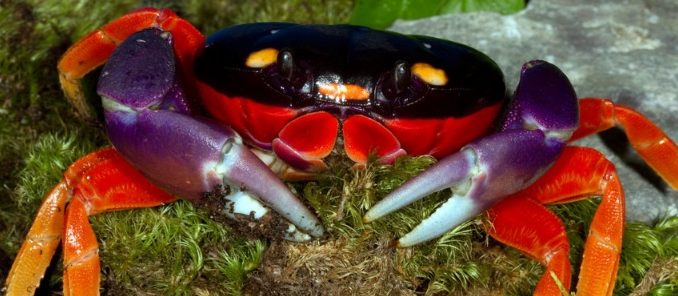
Have you ever seen a Halloween Moon Crab? They are definitely the most incredible-looking crabs in the world, with their crazy colours and their cute little faces. The most amazing thing about these curious, clacking critters is that they do very well in captivity and because of this, they make absolutely wonderful pets! Let’s introduce you to the wondrous world of Halloween Moon Crabs. In this article, we are going to give you some advice in order to give a wonderful life to these pets.
A Halloween Moon Crab As a Pet, Really?
Halloween Moon Crabs (also known as the Halloween Hermit Crab) are starting to be quite famous for their incredible ability to put up very well with captive life. They are also known for being very social creatures by nature: they seem to live longer and healthier lives when in the company of crabs of the same species. So, if you plan on getting a Halloween Moon Crab as a pet, you might as well take a pair straight.
Just know that they love to fight, sometimes even to death, so the best option would be to have them in separate tanks and let them play together now and them under surveillance. This will give you the time to admire their beautiful blackish carapace with brilliant jack-o’-lantern orange legs and their “dangerous-looking” purple claws that they happily raised into a sparring position if any uninvited fingers intrude: in fact, they actually look like they are just asking for a hug!
What about Halloween crab care?
Now let’s see how to care for a healthy Halloween Moon Crab, as even if they seem quite tame, they do however need some constant attention. Some pet store employees will say that crabs don’t require any special food, heat or substrate other than newspaper, water and table scraps, but don’t listen to them: those are the kind of employees that are here only to sell. Halloween Moon Crabs DO need special care and affection. But you’ll see, they are so cute that you might even struggle to let them sleep quietly.
Lifespan
When adopting one of these wonderful creatures, be aware that they have a quite long lifespan: they can live up to 8 to 10 years! So be ready for a long-lasting pet company. In order to give a better life-long experience for your Halloween moon crab, take care of its care sheet.
Reproducing the Halloween crab habitat
Halloween Moon Crabs are land crabs originally from the Pacific coast: we commonly find them from Mexico to Panama, where they can usually be found in mangrove, sand dunes and rain forests, although they do need to return to the ocean to breed. In order to reproduce their tropical habitat, they need constant moisture and an appropriate heating and lightning. And like any crab, they are nocturnal, so don’t be afraid if you never see it moving during the day, it’s not dead, it’s just sleeping. They also love climbing and digging: in their natural environment, they can go as deep as 4 feet to create a network of underground burrows where they can shelter, brumate and molt.
Choosing An Appropriate Tank Size
The minimum size for a single crab’s enclosure is a 15 to 20-gallon aquarium minimum (count at least 30 gallons for a pair). They might seem little while they are young and one could believe that they don’t need so much space, but even if they are not the biggest of crabs, they can still grow anywhere from 2 to 2.5 inches (5 to 6.5 cm) long and need space to stay happy. The environment you will provide them with must be able to sustain them in time as well as in space, especially if you plan on getting a pair like advised before. Remember that your Halloween crab tank size must be enough for him, don’t listen to pet shop employee who is going to advise you to take a 10-gallon size.
Providing a Proper Substrate
Now, we are going to talk about the Halloween crab tank setup. The optimal substrate for your crabs’ tank is about 4 to 6 inches (10 to 15 cm) of sand, plus an additional 3 to 6 inches (8 to 15 cm) of moist peat moss. Again, some might say that using basic newspaper as a substrate is well enough. Wrong! This is unacceptable. As we said, crabs love digging: they actually do need enough space to burrow deep into the moist (but not damp) substrate to molt. They can also go through a brumation phase during which they shelter underground (see below “About Molting and Brumation”). For these reasons, you must essentially go for an appropriate substrate, such as thin sand or airy earth, in which they will be able to dig freely.
Crabs Love Climbing
As we said, crabs love climbing, so you need to make sure to foster their natural instinct by providing places for that purpose: rocks, rough wood or branches, plastic plants or foliage and, even better, pieces of cork bark, which you can easily find in pet stores. Cork bark is practical because it is cheap, light and long-lasting. It is also specifically recommended as it is known for retaining water very efficiently, which helps keep a proper humidified environment needed by crabs (see below “They need constant moisture”). It also acts as a shelter , which is never too much as they need to hide during the day, given their nocturnal nature. You can also use coconut shells for aboveground housing.
They Need Constant Moisture
You always need to provide both fresh and saltwater in separate pools: one to drink, the other in order to keep their grills moist at all time, which is crucial to them. The pools must be wide enough to climb in and out, but also shallow as crabs do not swim and thus can drown easily! You can also add little rocks or shells on the bottom of the pools to help the crabs get in and out safely. Make sure to change water every day to ensure it doesn’t run dry and stays clean, and to prevent bacteria from growing (crabs are very sensitive to it). The best option is to use filtered or spring water to avoid the chemicals added to tap water.
Also, they need a constant level of humidity (around 70%). It is usually advised to get hold of a psychometer or something to measure humidity, and to spray the aquarium regularly in order to keep it to the right level.
Lightning and Heat
The optimal temperature to keep your Moon Crabs alive and healthy is around 26-27 °C (80°-85°F). It must never drop under 25°C (75°F) or raise above 30°C (85°F).
The most suitable lighting for crabs is a low wattage light bulb as it helps keep a high level of humidity while keeping the terrarium darker. Less light will make the crab feel more comfortable and safe while still providing enough light to see them and enough heat to create evaporation.
What do moon crabs eat?
If you bought a Halloween crab recently, you might ask what do sea crabs eat in captivity. Moon Crabs are largely herbivorous: they consume mainly leaf litter and seedlings. You can also feed them exotic fruits like mangoes, papayas or coconuts as it the kind of fruits they would find in their natural environment. Vegetables are also adequate as they provide proper nutrients. Meat is ok as well, as long as it is cooked thoroughly, otherwise, your crab may be at risk of health problems.
About quantities, know that crabs don’t eat when they are not hungry. On the other hand, they can die very quickly of undernourishment. So the best is to provide more food than necessary and remove the left-overs the following day (always clean the dish properly before adding more food; again, crabs are very sensitive to bacteria and mould).
Also, always remember to give them saltwater as it gives them the salt content they require in their original diet, and remember to provide a lot of calcium after molting (see below).
About Molting and Brumation
Molting is the process of the crab losing a layer of its exoskeleton and growing a new one, which happens about once a year (it can be twice a year or once every two years, depending on the crab and its environment). It can take up to several days to complete. You will see that your crab is about to molt when its colours are turning very dull and white appears around the eyes. In their natural habitat, crabs would molt underground, so it is advised to encourage darkness during the process and not to try to peak at or disturb it if it is hiding. After the process, we recommend you be very careful when handling your crab as its shell will be very weak during a couple of days.
When the process is completed, your crab will need to grow a new skin. For this, it will need a lot of calcium and other nutrients, which he will find… by eating its previous skin! So make sure to leave it in the tank. If it is not eaten within 2 days, then only it is ok to take it out of the container. You can also grind the remainder of the exoskeleton and add it to the next meal for a full healthy diet: this will help him to strengthen its new carapace. You can also find food supplement in exotic pet stores.
About brumation, know that it is not supposed to be a common natural process by crabs. They can go into a dormant phase, but it is not like a full hibernation. It often results from an inadequate environment (to cold for example). Just know that if he is not moving, it might not yet be dead, but you probably have to review the way you are caring for it.
Give Your Moon Crab Lots of Love!
Finally, know that like humans, each crab is different in its attitude and behaviour. Some will love to be handled, other won’t like it so much. If yours always want to pinch or stay tucked away, you should try to spend some time with it every day to help him get used to human interaction. After a while, you might be able to change its “crabby” disposition to a more human-friendly one and who knows, he might turn very attention-craving and not sky at all, like some other Moon Crabs. The best advice is to learn your crab’s behaviours and deal with them accordingly.

i just bought a moon crab today and he’s about 3in. 4-5in if you’re counting the legs. He has already eaten a large chunk of banana.
Hi Jake! We hope your moon crab will enjoy a long and happy life! Please share if you have any tips to add to our article, we would love to hear about it 🙂